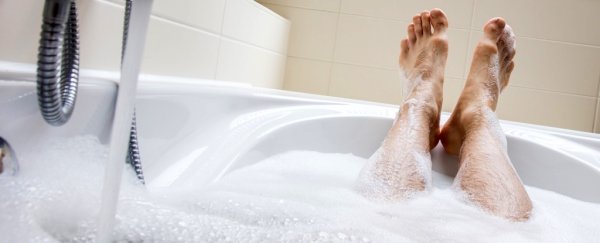Some things just sound too good to be true, like coffee supposedly making you live longer and chocolate making you smarter. In a reasonable Universe, such outcomes are unreasonably, unthinkably good.
Here's another one you might have heard of. Does a hot bath really burn as many calories as taking a 30-minute walk? It would be nice if it were true, honestly it would. Think about it: you get to take a nice, relaxing soak, while simultaneously reaping the benefits of moderate exercise. It's win-win.
The best part? It's for real.
A study released last year by exercise physiologist Steve Faulkner from Loughborough University in the UK found the mere act of taking a hot bath reduced mens' peak blood sugar levels while causing their energy expenditure to spike significantly.
Not bad for something you can do while leisurely reclining in the comfort and privacy of your bathroom.
"One of the first things that we were looking at is the energy expenditure while you're in the bath," Faulkner told the BBC in 2016, "and what we found was an 80 percent increase in energy expenditure just as a result of sitting in the bath for the course of an hour."
So, there are two things to be aware of upfront.
As stated, in the experiment the bath lasted for a whole hour, so you need some time on your hands if you want to try this at home.
The other is temperature. The study, which involved 14 men wearing glucose monitors, saw the temperature of the bath kept at a constant, hot 40 degrees Celsius (104 degrees Fahrenheit), so a lukewarm soak would produce different, and lesser results.
But why does it work at all?
Faulkner thinks the answer lies in what are called heat shock proteins – which we produce in both exercise, and, as the results show, passive heating, where body temperature is raised independently of exercise.
"Heat shock proteins are molecules that are made by all cells of the human body in response to stresses," Faulkner explained in The Conversation last year.
"In the long term, raised levels of these proteins may help the function of insulin and improve blood sugar control."
These kinds of proteins are known to be lower in people with diabetes, and Faulkner says the results suggest passive heating could be a useful technique to help people with type 2 diabetes control their glucose levels, in addition to helping with weight management generally.
Not that the researchers are saying everybody should quit their gym memberships and just take up bathing as a substitute.
While the men in the study burned an average of almost 140 calories per hour while taking their hot bath, they got a much better result from cycling for the same length of time – using up the equivalent of 630 calories.
Because of that almost-fivefold disparity, the researchers suggest passive heating should mostly be recommended for people whose health considerations for whatever reason make it difficult for them to engage in physical exercise.
In those cases, this could be the next best thing to obtaining the benefits of moderate exercise – and you can catch up on your reading at the same time. Not to mention getting clean, and just getting away from the world for a while.
In fact, if you have the means – a bathtub and 60 minutes with nowhere to be – we'd recommend preparing yourself a nice hot one right now. Immerse yourself, relax, and – now that we know the science – feel the burn.
The findings are reported in Temperature.
